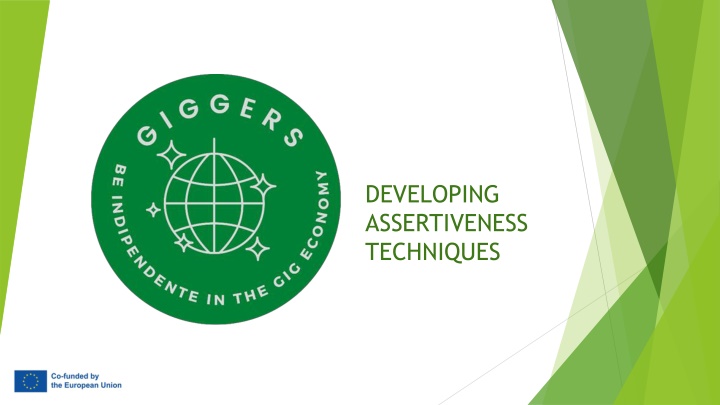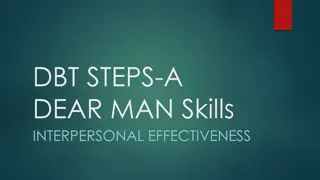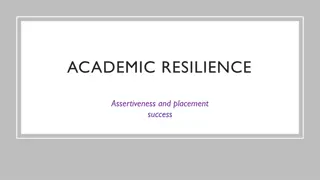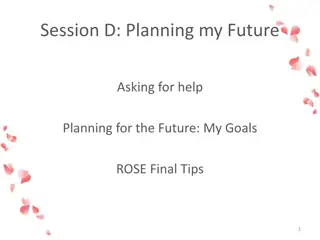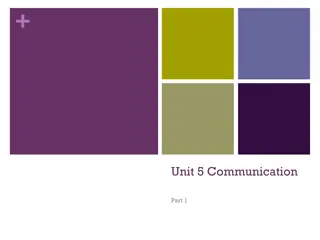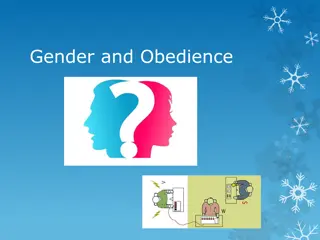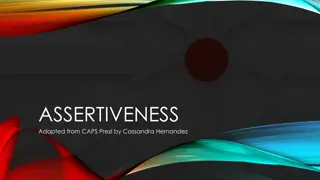DEVELOPING ASSERTIVENESS TECHNIQUES
Self-esteem and assertiveness are closely intertwined. Understanding self-worth is crucial for expressing thoughts, feelings, and boundaries assertively. Techniques like "I" statements and active listening play a key role in promoting assertiveness in communication.
Download Presentation

Please find below an Image/Link to download the presentation.
The content on the website is provided AS IS for your information and personal use only. It may not be sold, licensed, or shared on other websites without obtaining consent from the author.If you encounter any issues during the download, it is possible that the publisher has removed the file from their server.
You are allowed to download the files provided on this website for personal or commercial use, subject to the condition that they are used lawfully. All files are the property of their respective owners.
The content on the website is provided AS IS for your information and personal use only. It may not be sold, licensed, or shared on other websites without obtaining consent from the author.
E N D
Presentation Transcript
DEVELOPING ASSERTIVENESS TECHNIQUES
Understanding self-esteem and its relation to assertiveness Self-esteem refers to an individual's overall evaluation and perception of their own worth and value. It involves how they feel about themselves, what they believe about their abilities and qualities, and the degree of confidence they possess. Self-esteem plays a crucial role in shaping a person's thoughts, emotions, and behaviors.
Assertiveness, on the other hand, refers to the ability to express one's thoughts, opinions, needs, and wishes in a respectful and confident manner, while also considering the rights and feelings of others. It involves confidently standing up for oneself, setting boundaries, and communicating effectively. Self-esteem and assertiveness are closely interconnected. Having a healthy level of self-esteem is necessary for assertive behavior. When individuals have a positive self-image and believe in their own value, it enables them to express themselves confidently and assertively. They are more likely to feel deserving of respect, to assert their rights, and to communicate their needs without fear of rejection or excessive concern for others' opinions.
Conversely, low self-esteem often leads to difficulties in assertiveness. Individuals with low self-esteem may have negative beliefs about themselves, doubt their own abilities, and fear rejection or confrontation. As a result, they may struggle to voice their opinions, set boundaries, or ask for what they want, leading to passive or aggressive behaviors instead of assertiveness. In summary, self-esteem provides the foundation for assertiveness. Individuals with healthy self-esteem are more likely to assert themselves confidently, while those with low self-esteem may struggle to express themselves assertively. Developing and enhancing self- esteem can significantly influence a person's ability to communicate assertively and maintain healthy relationships.
Techniques for expressing thoughts, feelings, and boundaries assertively Expressing thoughts, feelings, and boundaries assertively involves effective communication techniques that promote assertiveness while maintaining respect for oneself and others. Some techniques for expressing oneself assertively include:
"I" statements: Instead of blaming or criticizing others, using "I" statements allows individuals to express their thoughts, feelings, and boundaries in a non- confrontational manner. For example, saying "I feel upset when you interrupt me" rather than "You always interrupt me." Active listening: Being an active listener involves giving full attention to the speaker, maintaining eye contact, and acknowledging their feelings and perspective. By listening empathetically, individuals can respond assertively, understanding the other person's point of view while still expressing their own thoughts and boundaries.
Non-verbal cues: Body language, tone of voice, and facial expressions play a significant role in assertive communication. Appropriate non-verbal cues such as maintaining an upright posture, steady eye contact, and a calm and confident tone contribute to conveying thoughts and boundaries assertively. Practicing self-assertiveness: Developing self- confidence and self-esteem is crucial for expressing thoughts and feelings assertively. Building self- awareness, setting personal goals, and practicing self- assertiveness techniques like positive self-talk and self-advocacy can enhance assertive communication.
Using assertive language: Utilizing assertive language involves being direct, specific, and clear in conveying thoughts and feelings. This ensures that the intended message is understood without being aggressive or passive. It is important to avoid generalizations, apologize for expressing oneself, or use minimizing phrases like "I'm sorry, but..." Conflict resolution skills: When conflicts arise, assertive communication techniques can help address them effectively. Openly discussing the issue, actively listening to the other person's perspective, expressing thoughts and boundaries assertively, and seeking compromise or win-win solutions are key aspects of assertive conflict resolution.
Overall, the techniques for expressing thoughts, feelings, and boundaries assertively aim to promote open and honest communication, while also respecting the rights and perspectives of others. By utilizing these techniques, individuals can effectively express themselves, build healthier relationships, and maintain their personal boundaries.
"The European Commission's support for the production of this publication does not constitute an endorsement of the contents, which reflect the views only of the authors, and the Commission cannot be held responsible for any use which may be made of the information contained thereinProject Number: 2022-1-DE-KA220-ADU-000086609
